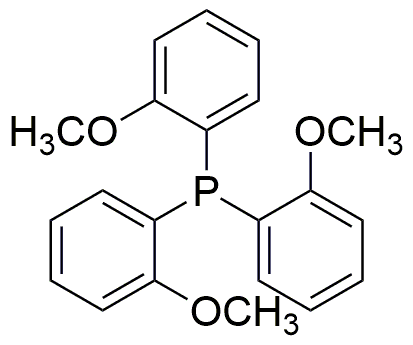Tris(2-methoxyphenyl)phosphine is widely utilized in research focused on:
- Catalysis: This compound serves as a ligand in various catalytic processes, enhancing reaction rates and selectivity in organic synthesis, particularly in cross-coupling reactions.
- Pharmaceutical Development: It is employed in the synthesis of pharmaceutical intermediates, facilitating the creation of complex molecules used in drug formulations.
- Material Science: The compound is used in the development of advanced materials, including polymers and nanocomposites, which benefit from its unique electronic properties.
- Organic Electronics: It plays a role in the fabrication of organic light-emitting diodes (OLEDs) and organic photovoltaics, contributing to the efficiency and stability of these devices.
- Research in Coordination Chemistry: Tris(2-methoxyphenyl)phosphine is valuable in studying coordination complexes, helping researchers understand metal-ligand interactions and their applications in various fields.
General Information
Properties
Safety and Regulations
Applications
Tris(2-methoxyphenyl)phosphine is widely utilized in research focused on:
- Catalysis: This compound serves as a ligand in various catalytic processes, enhancing reaction rates and selectivity in organic synthesis, particularly in cross-coupling reactions.
- Pharmaceutical Development: It is employed in the synthesis of pharmaceutical intermediates, facilitating the creation of complex molecules used in drug formulations.
- Material Science: The compound is used in the development of advanced materials, including polymers and nanocomposites, which benefit from its unique electronic properties.
- Organic Electronics: It plays a role in the fabrication of organic light-emitting diodes (OLEDs) and organic photovoltaics, contributing to the efficiency and stability of these devices.
- Research in Coordination Chemistry: Tris(2-methoxyphenyl)phosphine is valuable in studying coordination complexes, helping researchers understand metal-ligand interactions and their applications in various fields.
Documents
Safety Data Sheets (SDS)
The SDS provides comprehensive safety information on handling, storage, and disposal of the product.
Product Specification (PS)
The PS provides a comprehensive breakdown of the product’s properties, including chemical composition, physical state, purity, and storage requirements. It also details acceptable quality ranges and the product's intended applications.
Certificates of Analysis (COA)
Search for Certificates of Analysis (COA) by entering the products Lot Number. Lot and Batch Numbers can be found on a product’s label following the words ‘Lot’ or ‘Batch’.
*Catalog Number
*Lot Number
Certificates Of Origin (COO)
This COO confirms the country where the product was manufactured, and also details the materials and components used in it and whether it is derived from natural, synthetic, or other specific sources. This certificate may be required for customs, trade, and regulatory compliance.
*Catalog Number
*Lot Number
Safety Data Sheets (SDS)
The SDS provides comprehensive safety information on handling, storage, and disposal of the product.
DownloadProduct Specification (PS)
The PS provides a comprehensive breakdown of the product’s properties, including chemical composition, physical state, purity, and storage requirements. It also details acceptable quality ranges and the product's intended applications.
DownloadCertificates of Analysis (COA)
Search for Certificates of Analysis (COA) by entering the products Lot Number. Lot and Batch Numbers can be found on a product’s label following the words ‘Lot’ or ‘Batch’.
*Catalog Number
*Lot Number
Certificates Of Origin (COO)
This COO confirms the country where the product was manufactured, and also details the materials and components used in it and whether it is derived from natural, synthetic, or other specific sources. This certificate may be required for customs, trade, and regulatory compliance.


